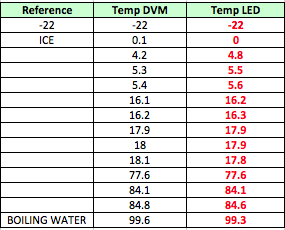1

 Air Temperature gauge Sun Dec 21, 2014 7:52 am
Air Temperature gauge Sun Dec 21, 2014 7:52 am
Born Again Eccentric
Life time member

Being an all year round rider, it is good to know what the air temperature is - for safety when it is cold and potentially icy and on those occasional (round here) warmer days to know how hot it really is. Cars have temperature gauges fitted as standard, but older bikes certainly do not.
I had hoped to use the temperature feature on my Garmin GPS, but it relies on connecting to my mobile phone and only gives the data from the local weather page rather than actual here and now information.
Had a look on Amazon and came up with this little device

As you can see, it is very compact and is designed to slot into a dash panel. This particular one comes with a 1m long sensor cable which is more than adequate - you can get them with a 3m cable too. I opted for a red LED display as I figured it would be better for use in the dark, but you can get green, yellow or blue LED versions too.
The claimed specs are:

As you can see, the temperature range is more than adequate for riding (anywhere in the world) but won't be damaged by sitting in extreme conditions (like full summer sunshine). The accuracy is also adequate for the purposes of measuring air temperature - after all, this is for useful information, not for anything more scientific. This model only outputs temperature in degrees celsius (I don't know whether there is a Fahrenheit version available for the US market).
It took a couple of weeks for the unit to be delivered, as it came from Hong Kong. As soon as I got it, I set about a little experiment to see whether it was accurate or not. I connected it to my spare 12V bike battery and put the temperature probe in a number of different locations of known (and some unknown ambient temperatures). At the same time, I connected the temperature probe to my Fluke DVM to use as a direct comparison (accuracy +/- 1%). These were the results:

The result showed that the temperature read out was pretty close to that of the DVM across the range -22 degC to 100 deg C. I did note that it was slower to respond than the DVM thermocouple when exposed to markedly different temperatures, but for bike use where the temperature gradients are much more limited, I don't see this as a problem. For the boiling water (expected temp 100 deg C), I did not compensate for my altitude (86m above sea level) nor atmospheric pressure at the time - both of which could influence the actual boiling point of water). It also showed me that my deep freeze is 4 deg colder than the -18 deg C setting that I was expecting to see.
Satisfied with the accuracy of the unit, I then set about mounting it on the bike. The obvious place was on the flat section in the centre of the dash panel, between the fuel gauge and the water temperature gauge. While the depth of the unit is not great, care is needed to ensure that it does not foul the internals of the map reading light below it. Cutting out the panel was a slow affair - I didn't want to use a jig saw as the vibrations could affect the other gauges (and I couldn't be bothered with taking them off during the cutting. Instead, I used the "hot knife" attachment on my gas powered soldering iron to carefully melt through the plastic and cut out the necessary slot. I tidied up the edges with a craft knife blade and used a smooth file to get the hole dimensions exactly right to receive the temperature display. Finally, having checked for a good fit, I secure the unit in place with a thin bead of adhesive.
The unit needs 7 - 30 volts dc....ideal for a bike mount. I connected mine to the supply that goes to my 12V power outlet on the left hand side of my dash so that it only gets power when the ignition is switched on.
As mentioned earlier, the unit comes with a 1m long sensor cable - I threaded this down into the space in front fairing (near the horn) and coiled up the excess cable to prevent it rattling around or fouling the steering. In this location, it is able to read ambient air temperature, but also remains dry so I am not inadvertently reading a wet bulb temperature (i.e. temperature with wind chill affect) on those soggy rides.
When I first used the bike with the temperature gauge fitted (riding to work when it was still dark), I noticed that I was getting an annoying reflection of the LED on the bike screen - bit like a heads up display, but in mirror writing. To prevent this, I fabricated a small plastic hood that fits over the temperature gauge. I can now see the temperature reading clearly from the riding position and the reflection on the screen has been eliminated.

So, there you have it. A fairly cheap and effective ambient air temperature display that integrates nicely with the other bike instruments.
Further details at the following link:
http://www.amazon.co.uk/s/ref=nb_sb_noss?url=search-alias%3Daps&field-keywords=DEOK+0.36%22+Digital+Thermometer+Red+LED+-55-125°c+Temp+Measure+DS18B20+Sensor
I had hoped to use the temperature feature on my Garmin GPS, but it relies on connecting to my mobile phone and only gives the data from the local weather page rather than actual here and now information.
Had a look on Amazon and came up with this little device

As you can see, it is very compact and is designed to slot into a dash panel. This particular one comes with a 1m long sensor cable which is more than adequate - you can get them with a 3m cable too. I opted for a red LED display as I figured it would be better for use in the dark, but you can get green, yellow or blue LED versions too.
The claimed specs are:

As you can see, the temperature range is more than adequate for riding (anywhere in the world) but won't be damaged by sitting in extreme conditions (like full summer sunshine). The accuracy is also adequate for the purposes of measuring air temperature - after all, this is for useful information, not for anything more scientific. This model only outputs temperature in degrees celsius (I don't know whether there is a Fahrenheit version available for the US market).
It took a couple of weeks for the unit to be delivered, as it came from Hong Kong. As soon as I got it, I set about a little experiment to see whether it was accurate or not. I connected it to my spare 12V bike battery and put the temperature probe in a number of different locations of known (and some unknown ambient temperatures). At the same time, I connected the temperature probe to my Fluke DVM to use as a direct comparison (accuracy +/- 1%). These were the results:

The result showed that the temperature read out was pretty close to that of the DVM across the range -22 degC to 100 deg C. I did note that it was slower to respond than the DVM thermocouple when exposed to markedly different temperatures, but for bike use where the temperature gradients are much more limited, I don't see this as a problem. For the boiling water (expected temp 100 deg C), I did not compensate for my altitude (86m above sea level) nor atmospheric pressure at the time - both of which could influence the actual boiling point of water). It also showed me that my deep freeze is 4 deg colder than the -18 deg C setting that I was expecting to see.
Satisfied with the accuracy of the unit, I then set about mounting it on the bike. The obvious place was on the flat section in the centre of the dash panel, between the fuel gauge and the water temperature gauge. While the depth of the unit is not great, care is needed to ensure that it does not foul the internals of the map reading light below it. Cutting out the panel was a slow affair - I didn't want to use a jig saw as the vibrations could affect the other gauges (and I couldn't be bothered with taking them off during the cutting. Instead, I used the "hot knife" attachment on my gas powered soldering iron to carefully melt through the plastic and cut out the necessary slot. I tidied up the edges with a craft knife blade and used a smooth file to get the hole dimensions exactly right to receive the temperature display. Finally, having checked for a good fit, I secure the unit in place with a thin bead of adhesive.
The unit needs 7 - 30 volts dc....ideal for a bike mount. I connected mine to the supply that goes to my 12V power outlet on the left hand side of my dash so that it only gets power when the ignition is switched on.
As mentioned earlier, the unit comes with a 1m long sensor cable - I threaded this down into the space in front fairing (near the horn) and coiled up the excess cable to prevent it rattling around or fouling the steering. In this location, it is able to read ambient air temperature, but also remains dry so I am not inadvertently reading a wet bulb temperature (i.e. temperature with wind chill affect) on those soggy rides.
When I first used the bike with the temperature gauge fitted (riding to work when it was still dark), I noticed that I was getting an annoying reflection of the LED on the bike screen - bit like a heads up display, but in mirror writing. To prevent this, I fabricated a small plastic hood that fits over the temperature gauge. I can now see the temperature reading clearly from the riding position and the reflection on the screen has been eliminated.

So, there you have it. A fairly cheap and effective ambient air temperature display that integrates nicely with the other bike instruments.
Further details at the following link:
http://www.amazon.co.uk/s/ref=nb_sb_noss?url=search-alias%3Daps&field-keywords=DEOK+0.36%22+Digital+Thermometer+Red+LED+-55-125°c+Temp+Measure+DS18B20+Sensor
__________________________________________________


Paul

"Heidi" K100LT 1991 (Grey) (VIN 0190172 Engine No. 104EB 2590 2213) - 5th owner. January 2014 (34,000 - 82,818 miles and counting....)
"Gretel" K100LT 1989 (
"Donor" K100LT 1990 (Red) (VIN 0178091 Engine gone to Dai) - 6th & final owner (crash write-off now donor bike). June 2012 (73,000 miles) to November 2013 (89,500 miles)


















